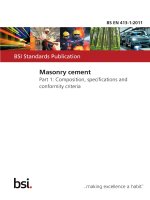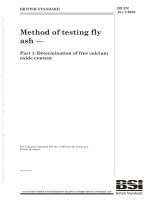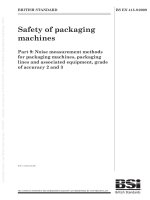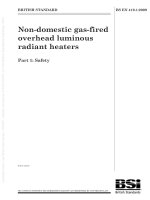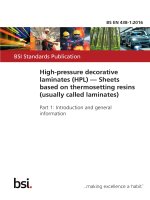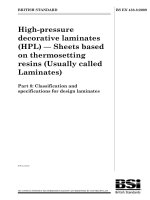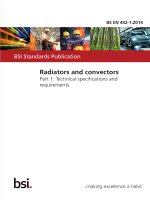Bsi bs en 62369 1 2009
Bạn đang xem bản rút gọn của tài liệu. Xem và tải ngay bản đầy đủ của tài liệu tại đây (9.41 MB, 76 trang )
BS EN 62369-1:2009
BSI British Standards
Evaluation of human exposure
to electromagnetic fields from
short range devices (SRDs) in
various applications over the
frequency range 0 GHz to
300 GHz —
Part 1: Fields produced by devices used for
electronic article surveilla nce, radio frequency
identification and similar systems
NO COPYING WITHOUT BSI PERMISSION EXCEPT AS PERMITTED BY COPYRIGHT LAW
raising standards worldwide™
BRITISH STANDARD
BS EN 62369-1:2009
National foreword
This British Standard is the UK implementation of EN 62369-1:2009. It is
identical to IEC 62369-1:2008. It supersedes BS EN 50357:2001 which is
withdrawn.
The UK participation in its preparation was entrusted to Technical
Committee GEL/106, Human exposure to low frequency and high frequency
electromagnetic radiation.
A list of organizations represented on this committee can be obtained on
request to its secretary.
This publication does not purport to include all the necessary provisions of a
contract. Users are responsible for its correct application.
© BSI 2009
ISBN 978 0 580 54645 7
ICS 13.280; 33.100.01
Compliance with a British Standard cannot confer immunity from
legal obligations.
This British Standard was published under the authority of the Standards
Policy and Strategy Committee on 30 April 2009.
Amendments issued since publication
Amd. No.
Date
Text affected
EUROPEAN STANDARD
EN 62369-1
NORME EUROPÉENNE
March 2009
EUROPÄISCHE NORM
ICS 33.050
Supersedes EN 50357:2001
English version
Evaluation of human exposure to electromagnetic fields
from short range devices (SRDs) in various applications
over the frequency range 0 GHz to 300 GHz Part 1: Fields produced by devices used for electronic article surveillance,
radio frequency identification and similar systems
(IEC 62369-1:2008)
Evaluation de l'exposition humaine
aux champs électromagnétiques
produits par les dispositifs radio
à courte portée dans la plage
de fréquence 0 GHz à 300 GHz Partie 1: Champs produits
par les dispositifs utilisés pour
la surveillance électronique des objets,
l'identification par radiofréquence
et les systèmes similaires
(CEI 62369-1:2008)
Ermittlung der Exposition
von Personen gegenüber
elektromagnetischen Feldern
im Frequenzbereich 0 GHz bis 300 GHz
durch Geräte mit kurzer Reichweite
für verschiedene Anwendungen Teil 1: Felder, die durch Geräte erzeugt
werden, die zur elektronischen
Artikelüberwachung,
Hochfrequenz-Identifizierung und für
ähnliche Anwendungen verwendet werden
(IEC 62369-1:2008)
This European Standard was approved by CENELEC on 2009-03-01. CENELEC members are bound to comply
with the CEN/CENELEC Internal Regulations which stipulate the conditions for giving this European Standard
the status of a national standard without any alteration.
Up-to-date lists and bibliographical references concerning such national standards may be obtained on
application to the Central Secretariat or to any CENELEC member.
This European Standard exists in three official versions (English, French, German). A version in any other
language made by translation under the responsibility of a CENELEC member into its own language and notified
to the Central Secretariat has the same status as the official versions.
CENELEC members are the national electrotechnical committees of Austria, Belgium, Bulgaria, Cyprus, the
Czech Republic, Denmark, Estonia, Finland, France, Germany, Greece, Hungary, Iceland, Ireland, Italy, Latvia,
Lithuania, Luxembourg, Malta, the Netherlands, Norway, Poland, Portugal, Romania, Slovakia, Slovenia, Spain,
Sweden, Switzerland and the United Kingdom.
CENELEC
European Committee for Electrotechnical Standardization
Comité Européen de Normalisation Electrotechnique
Europäisches Komitee für Elektrotechnische Normung
Central Secretariat: avenue Marnix 17, B - 1000 Brussels
© 2009 CENELEC
All rights of exploitation in any form and by any means reserved worldwide for CENELEC members.
Ref. No. EN 62369 1:2009 E
BS EN 62369-1:2009
EN 62369-1:2009
-2-
Foreword
The text of the International Standard IEC 62369-1:2008, prepared by IEC TC 106, Methods for the
assessment of electric, magnetic and electromagnetic fields associated with human exposure, was
submitted to the Unique Acceptance Procedure and was approved by CENELEC as EN 62369-1 on
2009-03-01 without any modification.
This European Standard supersedes EN 50357:2001.
The following dates were fixed:
– latest date by which the EN has to be implemented
at national level by publication of an identical
national standard or by endorsement
(dop)
2010-03-01
– latest date by which the national standards conflicting
with the EN have to be withdrawn
(dow)
2012-03-01
__________
Endorsement notice
The text of the International Standard IEC 62369-1:2008 was approved by CENELEC as a European
Standard without any modification.
In the official version, for Bibliography, the following notes have to be added for the standards indicated:
IEC 61566
NOTE Harmonized as EN 61566:1997 (not modified).
IEC 62209-1
NOTE Harmonized as EN 62209-1:2006 (not modified).
IEC 62311
NOTE Harmonized as EN 62311:2008 (modified).
ISO/IEC 17025
NOTE Harmonized as EN ISO/IEC 17025:2005 (not modified).
__________
BS EN 62369-1:2009
–2–
62369-1 © IEC:2008
CONTENTS
INTRODUCTION.....................................................................................................................7
1
Scope ...............................................................................................................................8
2
Normative references .......................................................................................................9
3
Terms, definitions, and abbreviations ...............................................................................9
4
3.1 Quantities................................................................................................................9
3.2 Constants ................................................................................................................9
3.3 Terms and definitions ............................................................................................ 10
Measurements and calculations for equipment evaluation .............................................. 15
4.1
4.2
Introduction ........................................................................................................... 15
Evaluation against reference values ...................................................................... 16
4.2.1 General ..................................................................................................... 16
4.2.2 Direct measurement for comparison against reference values ................... 16
4.2.3 Spatial measurements for comparison against reference values ................ 17
4.2.4 Modelling and analysis including field non-uniformity ................................. 17
4.3 Specific absorption rate (SAR) measurements....................................................... 24
4.3.1 General ..................................................................................................... 24
4.3.2 Internal electric field strength measurements ............................................. 24
4.3.3 Internal temperature measurements .......................................................... 25
4.3.4 Calorimetric measurements of heat transfer .............................................. 26
4.3.5 Phantom models and fluid ......................................................................... 26
4.4 Numerical evaluations for comparison against basic restrictions............................ 26
4.4.1 General ..................................................................................................... 26
4.4.2 Evaluations using homogeneous models ................................................... 26
4.4.3 Special case of inductive near-field exposure 100 kHz to 50 MHz.............. 28
4.4.4 Frequencies > 50 MHz............................................................................... 29
4.4.5 Localised SAR (100 kHz to 10 GHz) .......................................................... 29
4.5 Evaluations using non-homogeneous models for comparison against basic
restrictions ............................................................................................................ 30
4.5.1 General ..................................................................................................... 30
4.5.2 Anatomical body models ............................................................................ 30
4.5.3 Calculation/modelling method .................................................................... 31
4.5.4 Position of the body in relation to the unit under evaluation ....................... 31
4.6 Measurement of limb and touch currents ............................................................... 31
Measurements for field monitoring .................................................................................. 32
www.bzfxw.com
5
5.1
5.2
6
General ................................................................................................................. 32
Field measurements .............................................................................................. 32
5.2.1 Measurement where persons spend significant periods of time .................. 32
5.2.2 Detailed measurements for non-transitory exposure .................................. 32
5.3 Additional evaluation ............................................................................................. 32
Exposure from sources with multiple frequencies or complex waveforms ........................ 33
7
Exposure from multiple sources ...................................................................................... 33
8
Uncertainty ..................................................................................................................... 34
8.1
8.2
General ................................................................................................................. 34
Evaluating uncertainties ........................................................................................ 34
8.2.1 Individual uncertainties .............................................................................. 34
BS EN 62369-1:2009
62369-1 © IEC:2008
–3–
8.2.2 Combining uncertainties ............................................................................ 35
Examples of typical uncertainty components ......................................................... 35
8.3.1 Measurement............................................................................................. 35
8.3.2 Numerical calculation ................................................................................ 35
8.4 Overall uncertainties ............................................................................................. 35
Evaluation report ............................................................................................................ 35
8.3
9
Annex A (informative) Characteristics of equipment ............................................................. 37
Annex B (informative) Information for numerical modelling ................................................... 47
Annex C (informative) A simplified method for summation of multiple sources ..................... 67
Annex D (informative) Uncertainty ....................................................................................... 70
Bibliography.......................................................................................................................... 71
Figure 1 – General torso grid ................................................................................................ 19
Figure 2 – General head grid ................................................................................................ 19
Figure 3 – Single floor standing antenna ............................................................................... 20
Figure 4 – Dual floor standing antenna ................................................................................. 20
Figure 5 – Single floor antenna ............................................................................................. 21
Figure 6 – Single ceiling antenna .......................................................................................... 21
Figure 7 – Combined floor and ceiling antennas.................................................................... 22
Figure 8 – “Walk-through” loop antenna ................................................................................ 22
www.bzfxw.com
Figure 9 – Counter or desk mounted antenna ....................................................................... 23
Figure 10 – Vertical, wall or frame mounted antenna............................................................. 23
Figure 11 – Hand-held antenna ............................................................................................. 24
Figure 12 – Disk model ......................................................................................................... 28
Figure 13 – Cubic model ....................................................................................................... 28
Figure 14 – Spheroid model .................................................................................................. 28
Figure A.1 – Example of exit mounted equipment showing detection range ........................... 40
Figure A.2 – Example of aisle mounted equipment................................................................ 40
Figure A.3 – Inductive coupling ............................................................................................. 42
Figure A.4 – Electromagnetic coupling .................................................................................. 42
Figure A.5 – Capacitive coupling........................................................................................... 42
Figure A.6 – Overview of an RFID system............................................................................. 44
Figure B.1 – Current induced in a loop .................................................................................. 47
Figure B.2 – Disk model........................................................................................................ 51
Figure B.3 – Disk model used for validations ........................................................................ 51
Figure B.4 – Cubic model...................................................................................................... 52
Figure B.5 – Cubic model example showing current induced in 3 dimensions....................... 53
Figure B.6 – Prolate spheroid ............................................................................................... 54
Figure B.7 – Helmholtz coils and prolate spheroid................................................................. 55
Figure B.8 – 60 cm by 30 cm prolate spheroid results (magnetic field) .................................. 56
Figure B.9 – 60 cm by 30 cm prolate spheroid results (induced current density) ................... 56
Figure B.10 – 120 cm by 60 cm prolate spheroid results (magnetic field) .............................. 57
Figure B.11 – 120 cm by 60 cm prolate spheroid results (induced current density)................ 57
Figure B.12 – 160 cm by 80 cm prolate spheroid results (magnetic field) .............................. 58
BS EN 62369-1:2009
–4–
62369-1 © IEC:2008
Figure B.13 – 160 cm by 80 cm prolate spheroid results (induced current density)................ 58
Figure B.14 – Homogeneous human shape body model ........................................................ 60
Figure B.15 – Homogeneous human shape (induced current) ............................................... 60
Figure B.16 – Homogeneous hand model.............................................................................. 61
Figure B.17 – Approximate conductivities for LF homogeneous body modelling ................... 66
Table 1 – Dimensions and distances for Figures 1 to 11 ....................................................... 18
Table 2 – Dimensions and distances for simplified body shapes ........................................... 27
Table 3 – Maximum total evaluation uncertainties ................................................................. 35
Table A.1 – Frequency ranges and typical system characteristics ......................................... 43
Table A.2 – Example frequency bands and their applications ................................................ 43
Table B.1 – Disk model dimensions for Figure B.2 ................................................................ 51
Table B.2 – Cubic disk model dimensions for Figure B.4 ....................................................... 52
Table B.3 – Prolate spheroid dimensions for Figure B.6 ........................................................ 54
Table B.4 – Summary of results ............................................................................................ 59
Table B.5 – Examples of anatomical models ......................................................................... 62
Table B.6 – Conductivity of tissue types................................................................................ 64
Table B.7 – Relative permittivity of tissue types .................................................................... 65
www.bzfxw.com
BS EN 62369-1:2009
62369-1 © IEC:2008
–7–
INTRODUCTION
Electromagnetic fields interact with the human body and other biological systems through a
number of physical mechanisms. The main mechanisms of interaction are based on nervous
system effects and heating. These effects are dependent on frequency and are defined by
biologically relevant quantities. Based on these scientifically established health effects, there
are international, regional and sometimes national exposure requirements. These are set as
basic restrictions on quantities, which are not necessarily directly measurable, and contain
high safety factors to ensure a high level of protection. These quantities may be determined
either by calculation for each case, or by measuring a reference value that has a pre-derived
relationship to them, usually under worst-case, far-field conditions. Respect of the reference
value will ensure respect of the relevant basic restriction, except in some specific near field
situations which would normally be identified or highlighted within the applicable exposure
guidelines. If the measured quantity exceeds the reference value, it does not necessarily
follow that the basic restriction is also exceeded. Under those circumstances, more detailed
evaluation techniques will be necessary which are specific to that type of equipment and
exposure.
This document is part of a multi-part standard covering the evaluation of human exposure to
electromagnetic fields from short range devices (SRDs) in various applications over the
frequency range from 0 GHz to 300 GHz.
www.bzfxw.com
BS EN 62369-1:2009
–8–
62369-1 © IEC:2008
EVALUATION OF HUMAN EXPOSURE TO ELECTROMAGNETIC FIELDS
FROM SHORT RANGE DEVICES (SRDS) IN VARIOUS APPLICATIONS
OVER THE FREQUENCY RANGE 0 GHz to 300 GHz –
Part 1: Fields produced by devices used for electronic article
surveillance, radio frequency identification and similar systems
1
Scope
This part of IEC 62369 presents procedures for the evaluation of human exposure to
electromagnetic fields (EMFs) from devices used in electronic article surveillance (EAS), radio
frequency identification (RFID) and similar applications. It adopts a staged approach to
facilitate compliance assessment. The first stage (Stage 1) is a simple measurement against
the appropriate derived reference values. Stage 2 is a more complex series of measurements
or calculations, coupled with analysis techniques. Stage 3 requires detailed modelling and
analysis for comparison with the basic restrictions. When assessing any device, the most
appropriate method for the exposure situation may be used.
At the time of writing this International Standard, electronic article surveillance, radio
frequency identification and similar systems do not normally operate at frequencies below
1 Hz or above 10 GHz. EMF exposure guidelines and standards can cover a wider range of
frequencies, so clarification on the required range is included as part of the evaluation
procedures.
www.bzfxw.com
The devices covered by this document normally have non-uniform field patterns. Often these
devices have a very rapid reduction of field strength with distance and operate under nearfield conditions where the relationship between electric and magnetic fields is not constant.
This, together with typical exposure conditions for different device types, is detailed in
Annex A.
Annex B contains comprehensive information to assist with numerical modelling of the
exposure situation. It includes both homogeneous and anatomical models as well as the
electrical properties of tissue.
This International Standard does not include limits. Limits can be obtained from separately
published human exposure guidelines. Different guidelines and limit values may apply in
different regions. Linked into the guidelines are usually methods for summation across wider
frequency ranges and for multiple exposure sources. These shall be used. A simplified
method for summation of multiple sources is contained in Annex C. This has to be used with
care as it is simplistic and will overestimate the exposure; however it is useful as a guide,
when the results of different evaluations are in different units of measure which are not
compatible.
Different countries and regions have different guidelines for handling the uncertainties from
the evaluation. Annex D provides information on the two most common methods.
A bibliography at the end of this standard provides general information as well as useful l
information for the measurement of electromagnetic fields. See [ 1],[ 2],[3],[4],[ 5],[6] 1) .
Similar national or international standards may be used as an alternative.
———————
1) Figures between brackets refer to the bibliography.
BS EN 62369-1:2009
62369-1 © IEC:2008
2
–9–
Normative references
None.
3
Terms, definitions, and abbreviations
The internationally accepted SI units are used throughout this document.
3.1
Quantities
Quantity
Symbol
Unit
Dimension
Magnetic flux density
B
tesla (Vs/m 2 )
T
Electric flux density
D
coulomb per square metre
Cm 2
Electric field strength
E
volt per metre
Vm 1
Frequency
f
hertz
Hz
Magnetic field strength
H
ampere per metre
Am 1
Current density
J
ampere per square metre
Am 2
Power density
S
watt per square metre
Wm 2
Specific absorption rate
SAR
watt per kilogram
Wkg 1
Temperature
T
kelvin
K
Permittivity
ε
farad per metre
Fm 1
Wavelength
λ
metre
m
Permeability
μ
henry per metre
Hm 1
Mass density
ρ
kilogram per cubic metre
kgm 3
Electric conductivity
σ
siemens per metre
Sm 1
3.2
www.bzfxw.com
Constants
Physical constant
Symbol
Magnitude
Velocity of light in free space
c
2,998 × 10 8 ms 1
Permittivity of free space
ε0
8,854 × 10 12 Fm 1
Permeability of free space
μ0
4π × 10 7 Hm 1
Impedance of free space
Z0
120π (or 377) Ω
BS EN 62369-1:2009
62369-1 © IEC:2008
– 10 –
3.3
Terms and definitions
3.3.1
antenna
antennas are conductive elements that radiate, and/or receive energy in the radio frequency
spectrum
3.3.2
average (temporal) absorbed power
P avg
time – averaged rate of energy transfer defined by:
Pavg =
1
t 2 − t1
t2
³ P (t )dt
t1
where t 1 and t 2 are the start and stop time of the exposure (the period t 2 – t 1 is the exposure
duration)
3.3.3
averaging time
t avg
appropriate time over which exposure is averaged for purposes of determining compliance
3.3.4
bandwidth
range or band of frequencies in the electromagnetic spectrum within which a system is
capable of receiving and transmitting
www.bzfxw.com
3.3.5
basic restrictions (or basic limits)
values for human exposure to time-varying electric, magnetic, and electromagnetic fields that
are based on levels for which there are established health effects, with a high level of safety
included. These values may be defined in terms of induced current density, in-situ electric
field, specific absorption rate or similar dosimetric quantity
3.3.6
carrier
frequency used to carry data by appropriate modulation of the carrier waveform
3.3.7
conductivity
σ
ratio of the conduction–current density in a medium to the electric field strength in the medium
J = σE
3.3.8
current density
J
electromagnetic field-induced current per unit area inside the body
3.3.9
deactivator
device which changes transponders so that they no longer respond
BS EN 62369-1:2009
62369-1 © IEC:2008
– 11 –
3.3.10
dielectric constant
ε
See permittivity.
3.3.11
electric field strength
E
magnitude of a field vector at a point that represents the force ( F ) on an infinitely small charge
( q ) divided by the charge
E=
F
q
3.3.12
electric flux density
D
magnitude of a field vector that is equal to the electric field strength ( E ) multiplied by the
permittivity ( ε )
D = εE
3.3.13
electronic article surveillance
EAS
system which detects the presence of transponders, which is often used for anti-theft
purposes
www.bzfxw.com
3.3.14
exposure
exposure occurs whenever and wherever a person is subjected to electric, magnetic or
electromagnetic fields or to touch currents other than those originating from physiological
processes in the body and other natural phenomena
3.3.15
exposure level
value of the quantity under analysis when a person is exposed to electromagnetic fields or
touch currents
3.3.16
exposure requirements
standard, recommendation, set of guidelines or limits or other document that defines exposure
levels for guidance, assessment or compliance purposes
3.3.17
far-field
that region of the field of an antenna where the angular field distribution is essentially
independent of the distance from the antenna. In this region (also called the free space
region), the field has a predominantly plane-wave character, i.e. locally uniform distribution of
electric field strength and magnetic field strength in planes transverse to the direction of
propagation
3.3.18
harmonics
multiples of a principal frequency, invariably exhibiting lower amplitudes
BS EN 62369-1:2009
62369-1 © IEC:2008
– 12 –
3.3.19
induced current
current induced inside the body as a result of direct exposure to electromagnetic fields
3.3.20
interrogator
module in which all the basic processing of the data protocol takes place and there is an
interface to the transponder (for communicating and facilitating data transfer). An interrogator
is often also known as a reader.
3.3.21
magnetic flux density
B
magnitude of a field vector that is equal to the magnetic field H multiplied by the permeability
( μ) of the medium
B = μH
3.3.22
magnetic field strength
H
magnitude of a field vector in a point that results in a force ( F ) on a charge ( q ) moving with
velocity ( v )
F = q (Ȟ × μ H
)
www.bzfxw.com
[or magnetic flux density divided by permeability of the medium, see “magnetic flux density”]
3.3.23
near-field
region generally in proximity to an antenna or other radiating structure, in which the electric
and magnetic fields do not have a substantially plane-wave character, but vary considerably
from point to point. The near–field region is further subdivided into two sub-regions. The
reactive near-field region is closest to the radiating structure and contains most or nearly all
of the stored energy. The radiating near-field region is where the radiation field
predominates over the reactive field, but lacks substantial plane-wave character and is
complicated in structure
3.3.24
permeability
μ
property of a material which defines the relationship between magnetic flux density B and
magnetic field strength H . It is commonly used as the combination of the permeability of free
space and the relative permeability for specific dielectric materials
μ = μR μ0 = B/H
where
μ
is the permeability of the medium expressed in henrys per metre (Hm 1 )
μ0
is the permeability of a vacuum
μR
is the relative permeability
3.3.25
permittivity
ε
property of a dielectric material (e.g. biological tissue) which defines the relationship between
electrical flux density D and electrical field strength E . It is commonly used as the combination
BS EN 62369-1:2009
62369-1 © IEC:2008
– 13 –
of the permittivity of free space and the relative permittivity (or dielectric constant) for specific
dielectric materials
İ = İR İ 0 = D/E
where
ε
is the permittivity of the medium expressed in farads per metre (Fm 1 )
ε 0 is the permittivity of a vacuum
İR is the relative permittivity
3.3.26
power density
S
power per unit area normal to the direction of electromagnetic wave propagation. For plane
waves the power density ( S), electric field strength ( E) and magnetic field strength ( H ) are
related by the impedance of free space, i.e. 377 ȍ
S=
E2
= 377H 2 = EH
377
where E and H are expressed in units of Vm 1 and Am 1 , respectively, and S in Wm 2 .
NOTE Although many survey instruments indicate power density units, the actual quantities measured are E or H,
or the square of those quantities. It should be further noted that the value of 377 Ω is only valid for free space, far
field measurement conditions (and does not apply for inductive devices operating in the reactive near field).
www.bzfxw.com
3.3.27
radio frequency identification
RFID
system which reads the data stored in transponders, using electromagnetic fields. Some
system/transponder combinations also allow new or updated data to be transferred to the
transponders (read/write)
3.3.28
read
decoding, extraction and presentation of data from formatting, control and error management
bits sent from a transponder
3.3.29
read/write transponder
transponders that are capable of having their data repeatedly modified are called read/write
transponders
3.3.30
reference value
reference level
maximum permissible exposure
action value
value of exposure in a measurable quantity that has been conservatively derived from basic
restrictions or basic limits in such a way that compliance with the value ensures that there is
also compliance with the basic restrictions it is derived from. Non-compliance with the
reference value does not imply non-compliance with the basic restrictions it is derived from,
only that additional evaluations or actions are required to show such compliance.
BS EN 62369-1:2009
62369-1 © IEC:2008
– 14 –
3.3.31
root-mean-square (rms)
effective value or the value associated with joule heating, of a periodic electromagnetic wave.
The rms value is obtained by taking the square root of the mean of the squared value of a
function
X =
N
1
N
³ [f ( x )]
2
dx
0
Or in its equivalent form for a series of discrete parts
X =
N
1
N
¦ ( X n )2
n =1
NOTE Although many survey instruments indicate rms, the actual quantity measured is root sum square (rss)
(equivalent field strength). The value rss is obtained from three individual rms field strength values, measured in
three orthogonal directions combined disregarding the phases.
3.3.32
root-sum-square
rss
www.bzfxw.com
effective value or the value associated with joule heating, of a periodic electromagnetic wave.
The rss value is obtained by taking the square root of the sum of the squared value of a
function
N
X=
³ [f ( x )]
2
dx
0
Or in its equivalent form for a series of discrete parts
N
X =
¦ (X n )2
n =1
3.3.33
specific absorption rate
SAR
time derivative of the incremental electromagnetic energy ( d W) absorbed by (dissipated in) an
incremental mass ( d m) contained in a volume element ( d V) of given mass density ( )
SAR =
d Đ dW Ã
d Đ dW Ã
ă
á
ă
á=
dt â dm ạ dt â dV ạ
SAR is expressed in units of watts per kilogram (Wkg 1 ).
NOTE
SAR can be calculated by:
SAR =
σ Ei
ρ
2
BS EN 62369-1:2009
62369-1 © IEC:2008
– 15 –
SAR = c i
dT
dt
at t
0
where
Ei :
rms value of the electric field strength in the tissue in V/m
σ:
conductivity of body tissue in S/m
ρ:
density of body tissue in kg/m 3
ci :
specific heat capacity of body tissue in J kg 1 K 1
dT
dt
:
initial time derivative of temperature in body tissue in K/s
3.3.34
touch current
contact current
electric current passing through a human body or when it touches one or more accessible
parts of an installation or of equipment transponder
3.3.35
transponder
transmitter/receiver pair contained within a single package designed to respond to an external
interrogating signal. This is often also referred to as a tag, electronic tag, electronic label,
electronic bar-code, RFID chip, code plate and various other similar terms
www.bzfxw.com
3.3.36
wavelength
wavelength ( λ ) of an electromagnetic wave is related to the frequency (f) and velocity (Ȟ) of
the wave by the expression
Ȝ=
Ȟ
f
where Ȟ is the velocity of the wave in ms –1
NOTE
4
4.1
In free space the wave velocity is the velocity of light in free space, c.
Measurements and calculations for equipment evaluation
Introduction
This clause provides a three-stage method of exposure evaluation. The stages vary in
complexity and the one most suitable for the equipment and the exposure situation should be
used.
Evaluations are made either against basic restrictions or against derived reference values.
Reference value parameters are directly measurable and so are used for the simplest
evaluation method in 4.2. Basic restriction parameters provide a more fundamental evaluation
of exposure but are difficult or impossible to measure directly, so calculation, and numerical
modelling techniques are required. Evaluations against basic restrictions are provided in 4.4
and 4.5, with increasing levels of sophistication and complexity. In 4.4, the modelling takes
account of the non-uniformity of the fields, but not of human tissue. In 4.5, the modelling also
takes account of the non-uniformity of the human tissue and its properties.
Subclause 4.6 contains a method to demonstrate compliance for contact and limb currents.
This shall be used in all cases.
BS EN 62369-1:2009
– 16 –
4.2
4.2.1
62369-1 © IEC:2008
Evaluation against reference values
General
This subclause describes the method for determining compliance of a system to field strength
reference values.
The measuring instrumentation must be suitable for purpose and must cover the frequency
range of emissions from the unit under test. In the event that broadband instruments are used
the bandwidth of the instrumentation must cover the range of frequencies emitted. The
measuring instrumentation may have a frequency dependent response that correlates with the
limits. All measurement equipment used for the purposes of this standard shall be calibrated,
with traceable results, via a suitable accredited laboratory. The test site or facility used for
product compliance evaluations shall also be suitably calibrated; however this may not be
possible for measurements made at equipment installation sites. In the case of an uncalibrated test site or facility, care must be taken to avoid, or take into account, external
influences which could affect the results. All such effects and remedies should be noted in the
evaluation report, together with any uncertainties, which are created from them.
Instrumentation used to measure exposure levels may be commercially available or
specifically designed for purpose. IEC 61786 and IEC 61566 provide information about such
measurements and equipment.
In order to fully characterise the exposure conditions it may be necessary to use several
instruments, including broadband meters, oscilloscope or spectrum analyser. If more than one
instrument is used, some overlap of frequency range of the instrument may not be avoidable
however. In this case, unnecessary overevaluation of the levels should be minimized. Spectral
information is required to determine compliance with frequency dependent levels.
Measurements shall be performed using instrumentation capable of measuring relevant
frequency domain and time domain characteristics of the signal. In the case of time domain
measurements, it may be necessary to determine the frequency content to compare with the
reference values.
www.bzfxw.com
It is necessary to consider the frequency range of the emissions and any time varying
modulation. In addition, the duration of the exposure should be noted. These must be
considered where time averaging of exposure is allowed. It may be necessary to calculate the
instantaneous maximum field strength for comparison with limits for pulsed sources. It may
also be necessary to sum the field level at each frequency in accordance with the appropriate
exposure requirements.
It is important to consider the wavelength of the emissions with respect to the position of the
person to determine whether separate electric and magnetic field measurements are
necessary. In the near field, for example, it may only be necessary to measure magnetic
fields.
The measurements shall be carried out to determine the unperturbed field strengths. For
electric field measurements, the presence of the human body can significantly affect the field
and the instrumentation should be mounted on a non-conductive support. It may also be
appropriate to use a fibre-optic coupled remote read-out unit (or similar means of distancing
the body of the operator) for some electric field measurements.
If a power adjustment is available on the unit under test then this should be set to maximum
or adjusted according to the manufacturer’s setting up instructions. The unit under test should
be located at sufficient distance from nearby objects to ensure that the field is not perturbed.
4.2.2
Direct measurement for comparison against reference values
The field strengths shall be measured all around the unit under test at a distance X, as
defined in Table 1. A preliminary scan may be performed to determine the positions of
maximum electromagnetic field at this distance. The field strength shall be determined either
BS EN 62369-1:2009
62369-1 © IEC:2008
– 17 –
by a vector sum over three orthogonal measurement axes or by measuring the magnitude
from a single measurement aligned to give the maximum value. The electromagnetic field at
the maximum field positions shall be recorded.
If the emissions from the unit under test comply with reference values at all positions then the
equipment is compliant and no further evaluations are necessary, other than those in 4.5.
4.2.3
Spatial measurements for comparison against reference values
The methods described in this subclause are an option to be used instead of 4.2.1. It allows
the use of a measurement grid pattern over the typical exposed volume, to minimise the
measurements necessary.
For the types of equipment covered by this document (e.g., see Annex A), the torso is the
most appropriate area of the body to be assessed and the grid in Figure 1 shall be used. The
position of the grid in relation to the unit under test can vary according to the typical usage of
the unit. The layout and dimensions of the grid shall remain identical. In the exceptional cases
where the exposure is predominately to the head, then the grid in Figure 2 must be used. This
ensures that a more conservative result is obtained.
The measurement methods as described in the previous subclause shall apply and
measurements taken over the grid patterns defined in Figures 1 to 11 and Table 1. The actual
grid position used, in relation to the unit under test, depends on the typical equipment
configuration. Other grid positions than those described can be used provided that the
position used is representative of the normal use of the unit.
www.bzfxw.com
The measured values at each of the grid points shall be recorded and compared with the
appropriate derived reference values. This result shall be recorded.
In some exposure requirements, the reference values are based on spatially averaged values
over the entire body of the exposed individual. In such cases the appropriate linear or
quadratic average (rms) of the measured values should be calculated and compared with the
appropriate derived reference values. This result shall be recorded also.
It is important to note that while spatially averaged results may be applicable for whole body
exposure, substantial differences between individual values near to, or above the reference
values could indicate that localised basic restrictions might not be met. In such cases more
complex methods from other subclauses should be used to confirm that basic restrictions are
met.
For frequencies above 300 MHz and when the measurement is substantially in the far field,
measurements can be taken of E-field as above.
4.2.4
Modelling and analysis including field non-uniformity
The methods described in this subclause are an option to be used instead of 4.2.1 and 4.2.2.
For both near and far field evaluations, it is acceptable to use calculated fields for comparison
to reference values. Several suitable commercial packages are available for modelling field
patterns. The model should initially be validated by one or more comparative field
measurements and the comparison should be within reasonable measurement and modelling
uncertainties (see Clause 8).
This subclause also takes account of the non-uniform fields that are normal for the types of
equipment covered by this document at these frequencies. The near field extends for some
metres away from the unit, so all evaluations are made in the near field.
BS EN 62369-1:2009
62369-1 © IEC:2008
– 18 –
The fields may be measured using a finer grid than that used in 4.2. The grid size should be
commensurate with the spatial variation of the field, thus allowing realistic interpolation
between measurement points.
Field modelling is also an acceptable way to determine complex field patterns. Several
suitable commercial packages are available for this. The model should initially be validated by
one or more comparative field measurements and the comparison should be within
reasonable measurement and modelling uncertainties (see Clause 8).
Table 1 – Dimensions and distances for Figures 1 to 11
Figure g
Normative dimensions
cm e
a/b/c
X
Z
Informative dimensions
cm a,h
Height
General torso grid
1
15
85
General head grid b
2
10
145
Single floor standing unit
3
15
20
85
120 160
Dual floor standing units
4
15
20
85
120 160
Single unit in the floor f
5
15
85
Single unit in the ceiling
6
15
85
Dual floor/ceiling units f
7
15
“Walk through” unit f
8
15
9
15
Wall mounted unit
10
15
Hand held unit d
11
15
Counter mounted unit
c
Width
Depth
40 80
70 200
40 80
60 100
40 80
210 300
60 100
40 80
85
210 300
60 100
40 80
20
85
210 300
70 300
0,5 50
30
85
70 90
20 40
20 40
20
60 160
20 100
20 50
10
70 140
Area: 100 200 cm 2
www.bzfxw.com
a
These dimensions represent the range over which the majority of equipment falls. Some may fall outside the
range.
b
The total sum of the size of the head grid and Z dimension is 175 cm, which corresponds with the height
used for a standard person.
c
The X distance represents a typical distance when mounted in a counter top. If operated at closer distances,
occupational levels are most likely to apply.
d
If the hand held device is to be used to scan the human body, then an appropriate X distance should be
used. For close scanning devices an X distance of no more than 3 cm is appropriate.
e
In the case of equipment not falling into the above categories, it is permissible to use the nearest
appropriate category or use a new configuration using similar principles to those above.
f
Some units are buried a minimum distance below the top surface of the floor. This distance can be added to
the Z dimension, provided the requirement is clearly stated in the installation documentation.
g
The grid positions and dimensions reflect the position of the centre of the probe. The grey circle shows an
example of the probe position with respect to the grid.
h
Some units are circular or oval but approximate dimensions would reflect the rectangular sizes given.
BS EN 62369-1:2009
62369-1 © IEC:2008
– 19 –
Front view
Side view
Top view
IEC 1414/08
Figure 1 – General torso grid
www.bzfxw.com
IEC 1415/08
Figure 2 – General head grid
BS EN 62369-1:2009
62369-1 © IEC:2008
He ght
Depth
– 20 –
Depth
Front view
Side view
Top view
IEC 1416/08
Figure 3 – Single floor standing antenna
He ght
Depth
www.bzfxw.com
Width
Width
Front view
Depth
Side view
Top view
IEC 1417/08
Figure 4 – Dual floor standing antenna
BS EN 62369-1:2009
62369-1 © IEC:2008
Depth
– 21 –
Width
Floor
Width
Front view
Depth
Side view
Top view
IEC 1418/08
www.bzfxw.com
Figure 5 – Single floor antenna
Depth
He ght
Ceiling
Width
Width
Front view
Depth
Floor
Side view
Top view
IEC 1419/08
Figure 6 – Single ceiling antenna
BS EN 62369-1:2009
62369-1 © IEC:2008
– 22 –
Depth
He ght
Ceiling
Width
Width
Front view
Depth
Floor
Side view
Top view
IEC 1420/08
www.bzfxw.com
Figure 7 – Combined floor and ceiling antennas
Depth
He ght
Ceiling
Width
Floor
Width
Depth
Front view
Side view
Top view
IEC 1421/08
Figure 8 – “Walk-through” loop antenna
BS EN 62369-1:2009
62369-1 © IEC:2008
– 23 –
Depth
Width
He ght
Desk
Front view
Side view
IEC 1422/08
Figure 9 – Counter or desk mounted antenna
He ght
D ameter D
www.bzfxw.com
Front view
Side view
IEC 1423/08
Figure 10 – Vertical, wall or frame mounted antenna
BS EN 62369-1:2009
62369-1 © IEC:2008
– 24 –
Front view
IEC 1424/08
Figure 11 – Hand-held antenna
4.3
www.bzfxw.com
Specific absorption rate (SAR) measurements
4.3.1
General
There are three main methods to directly measure SAR in human body phantoms:
–
internal electric field strength measurements for evaluation of localised SAR;
–
internal temperature measurement for evaluation of localized SAR;
–
calorimetric measurement of heat transfer for evaluation of whole-body-averaged SAR.·
IEC 62209-1 and IEC 62209-2 contain considerable information on SAR measurement
procedures. The detailed procedures from those standards may be used as the basis for
evaluation of the devices, provided the method used is documented and provides results with
a known uncertainty (see Clause 8), or which inherently overestimate the exposure.
The following subclauses provide some general information and some specific information
relevant for SAR evaluation of devices covered by this standard, to assist when using
IEC 62209
4.3.2
Internal electric field strength measurements
Evaluation of SAR via E-field measurement is performed using a miniature probe that is
automatically positioned in a liquid-filled phantom model of the human body or a part of it (for
example: the head), which is exposed to an electromagnetic field. From the measured E-field
values, the SAR distribution and the maximum mass averaged SAR value can be calculated
according to
SAR =
σ 2
E
ρ i
(1)
